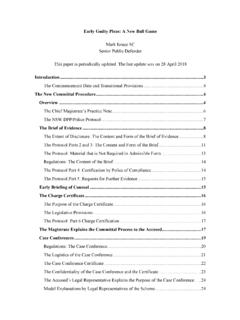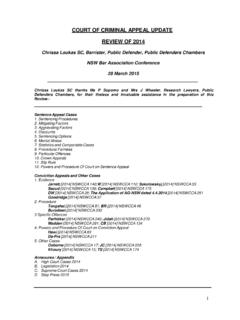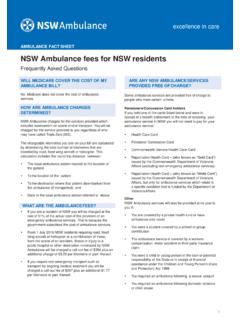Transcription of Appearing for the mentally impaired: Not guilty …
1 1 Appearing for the mentally impaired: Not guilty mental illness Conference to in-house solicitors Legal Aid NSW 12 February 2018 Any criminal lawyer practicing in new south wales knows that a significant proportion of the people we represent suffer from some sort of mental illness or impairment. Whilst there is no institutional data available that I am aware of as to the proportion of people with cognitive and mental health impairments involved in the NSW criminal court system generally, unsurprisingly, the figures gathered by Correctives indicate that such persons are overrepresented in the NSW prisons Recent studies indicate that the number of forensic patients continues to increase The mental health condition of your client may raise issues as to whether they are to be dealt with by way of criminal Court proceedings at all, taking into account the application of s. 32 of the Mental Health (Forensic Provisions) Act 1990 (NSW)( MHFPA ) within the Local Court of NSW.
2 In higher Courts issues of fitness to plead may be raised, and issues of cognitive or mental health may be relevant to the criminal responsibility of the accused, for example, in relation to the defence of not guilty by reason of mental illness ( NGMI ), or issues concerning non-insane automatism, or as a partial defence of substantial impairment in murder cases, open to them pursuant to 23A of the Crimes Act 1900 (NSW) The purpose of this paper is not to address all of the above avenues that may need to be considered by a practitioner Appearing for a client with such a condition, but to address the tests and parameters of the defence of not guilty by mental illness alone. Many excellent papers have been written on this same area, including Chris Bruce SC, Public Defender s paper Ethics and the mentally impaired (2011) available on the Public Defender s website, which additionally covers the area of fitness, and ethical issues that may arise where a client refuses to run NGMI when it is available on the Much assistance has been gained from the chapter The Defence of Mental Illness in the text Crime and Mental Health Law in new south wales authored by Dan Howard and psychiatrist Dr Bruce 1 NSW Law Reform Commission Report 135 (2012) People with cognitive and mental health impairments in the criminal justice system: Diversion at para and 2 As at June 2017, there were 566 forensic and correctional patients in NSW, an increase of 21% from 2015-2016.
3 Mental Health Review Tribunal ( MHRT ) 2016/2017 Annual Report for the period 1 July 2016 to 30 June 2017. 3 The cases dealing with this issue include R v JH (2009) NSWSC 551 and R v Hold 9 DCLR (NSW) 97; R v Smith (1999) NSWCCA 126; R v Williams (2004) NSWCCA 224 and R v Dezfouli (2007) NSWCCA 86. 4 Dan Howard and Dr Bruce Westmore Crime and Mental Health Law in new south wales (Lexis Nexis Butterworths 2nd Ed, 2010). I note that a new edition of this valuable text is due out during 2018. 2 To raise the defence of NGMI or not? And by whom? This is a fraught issue and one that no doubt causes much worry for the criminal trial lawyer. The decision as to whether to rely on this defence may be complicated by a number of ethical and forensic issues some of which will be apparent from an examination of the consequences of being made a forensic patient, as are set out towards the end of this paper. As will become apparent however, control over the availability of the defence may simply be taken out of the control of the accused s representative due to the application of s.
4 37 MHFPA. This provision requires an explanation as to the availability of the defence to be put to the jury if the question of mental illness is raised , regardless of whether it is embraced as a defence by the accused at trial. 37 Explanation to jury If, on the trial of a person charged with an offence, a question is raised as to whether the person was, at the time of commission of the offence, mentally ill as referred to in section 38, the Court must explain to the jury the findings which may be made on the trial and the legal and practical consequences of those findings and must include in its explanation: (a) a reference to the existence and composition of the Tribunal, and (b) a reference to the relevant functions of the Tribunal with respect to forensic patients, including a reference to the requirements of this Act that the Tribunal may make an order for the release of a person detained in accordance with section 39 only if the Tribunal is satisfied, on the evidence available to it, that the safety of the person or any member of the public will not be seriously endangered by the person's release.
5 Historically, the right of a trial judge to raise the issue of mental illness was considered and confirmed by the Court of England and wales , in circumstances where there was sufficient evidence of it before the Court: R v Dickie [1984] 3 All ER 173. It was nonetheless considered that the circumstances in which a judge would do so would be exceptional and very rare (Dickie at 178). The Court found however that there was no such precedent upon which they could rely to assume that the Crown had such a right, rather the Court found it had the power to rebut the issue if raised by the defence, and the obligation to make any evidence in its possession of insanity available to the defence so that they may exercise their discretion as to its proper use (Dickie at 178). In R v Damic [1982] 2 NSWLR 750; (1982) 6 A Crim R 35 the judge in a trial in which the accused was unrepresented required a psychiatrist to be called to give evidence in order to confirm that the applicant had schizophrenia at the time of the offences (after confirming that the accused had no objection).
6 He then invited the Crown Prosecutor to ask questions as amicus Street CJ, with whom Slattery J and Miles JJ agreed, expressed the need for caution in the exercise of a judge s power to call a witness, but in the circumstances of the case noted (at [765E]): 5 See also R v Issa (SCNSW, 16 October 1995, unreported) and Lo Tin [1964] Crim LR 135 (Supreme Court of Hong Kong). 3 The trial judge was, as he reported to this Court, gravely concerned at the implications from the point of view of justice of permitting a man suffering mental illness to be convicted of murder for which there were strong grounds for doubting his true criminal responsibility. If the judge had not intervened by calling the psychiatrist this is the result which would very likely have ensued. He was, in my view, acting entirely properly in taking this course, notwithstanding that the accused man did not in fact, and did not wish to, set up a defence of mental illness.
7 Indeed, if the judge had refrained from taking this course of his own motion, an unjust conviction could well have resulted. The present position, in accordance with s. 37, is that the trial judge is obliged to leave insanity to the jury where there is reasonable evidence of it, notwithstanding that it is not relied upon by the defence: Hawkins v R (1994) 179 CLR 500; 72 A Crim R 288 at 299; R v Foy (1922) 29 WN (NSW) 20; and R v Shields [1967] VR 706. In some cases directions on finding specific intent will necessarily involve the giving of directions concerning whether specific intent could have been informed in the context of evidence of mental illness: R v Minani (2005) 63 NSWLR 490; [2005] NSWCCA 226 per Hunt AJA at [31]-[32]. In R v Hilder (1997) 97 A Crim R 70, the Court set out the reasoning behind the giving of an explanation to the jury as to the ramifications of making a finding of NGMI in accordance with s 37.
8 The Court held that the trial judge was obliged to explain the legal and practical consequences of the findings so as to emphasise the contrast between punishment of the accused for his criminal conduct if found guilty , and treatment for his mental condition if there is a special verdict. In that way the jury would know that the accused would go free if found not guilty , but be detained until there was no longer any threat of danger to the public, following a special verdict. Hunt CJ at CL at 81: ..The point of explaining to the jury the legal and practical consequences of a guilty verdict is to emphasise the contrast between punishment of the accused for his criminal conduct if found guilty and treatment for his mental condition if there is a special verdict, just as the point of explaining to the jury the consequences of a not guilty verdict is to emphasise the contrast between going free if found not guilty and being detained until there is no longer any threat of danger to the public if there is a special verdict.
9 It was also argued that it was both unnecessary and prejudicial to tell the jury in this case that, if found guilty , the prisoner would go to gaol. I do not see why. Not only does it deal specifically with the question which was asked by the jury, it again emphasises the contrast between punishment and treatment. Even if I am wrong in my interpretation of s 37, I see no prejudice to an accused provided that the trial judge makes it clear to the jury, as the judge did here, that the only way in which the accused will certainly receive treatment for his mental condition is if they give the special verdict. That is no doubt why counsel then Appearing for the appellant did not object to the direction which was given. Ordinarily, it would also be necessary (or at least desirable) for the judge as well to make it clear to the jury that all this information is being given to them so that they understand what happens according to the verdict which they give, but that they should not let those consequences affect their consideration of which verdict they give.
10 Although the Court of Appeal of England and wales in Dickie (at 178) held that the Crown could not raise the insanity defence, the same is not the law in new south wales , consistent with the terms of s. 25. In R v Ayoub [1984] 2 NSWLR 511 the Court of Criminal Appeal 4 considered that, whether the issues is raised by the defence, the prosecution or the Court, the standard of proof is the same (Street CJ, Slattery J agreeing) at [ ]: In my view there is only one onus of proof to be applied in a criminal trial when an issue arises whether the accused should be found not guilty on the ground of mental illness. Whether that contention be advanced by the accused, by the Crown, or put by the judge of his own motion to the jury, the onus in each case is one of proof on the balance of probabilities. Procedure for the defence of mental illness The threshold question Prior to the consideration as to the application of the test for NGMI, the act or omission forming the actus reas of an offence must first be proved beyond a reasonable doubt: Stiles v R (1990) 50 A Crim R 13 at 22.










